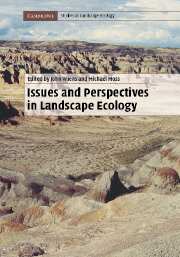Book contents
- Frontmatter
- Contents
- List of contributors
- Preface
- PART I Introductory perspectives
- PART II Theory, experiments, and models in landscape ecology
- PART III Landscape patterns
- PART IV Landscape dynamics on multiple scales
- PART V Applications of landscape ecology
- PART VI Cultural perspectives and landscape planning
- PART VII Retrospect and prospect
- Index
- Plate section
Preface
Published online by Cambridge University Press: 20 November 2009
- Frontmatter
- Contents
- List of contributors
- Preface
- PART I Introductory perspectives
- PART II Theory, experiments, and models in landscape ecology
- PART III Landscape patterns
- PART IV Landscape dynamics on multiple scales
- PART V Applications of landscape ecology
- PART VI Cultural perspectives and landscape planning
- PART VII Retrospect and prospect
- Index
- Plate section
Summary
In a broad sense, landscape ecology is the study of environmental relationships in and of landscapes. But what are “landscapes”? Are they heterogeneous mosaics of interacting ecosystems? Particular configurations of topography, vegetation, land use, and human settlement patterns? A level of organization that encompasses populations, communities, and ecosystems? Holistic systems that integrate human activities with land areas? Sceneries that have aesthetic values determined by culture? Arrays of pixels in a satellite image? Depending on one's perspective, landscapes are any or all of these, and more. Landscape ecology is therefore a diverse and multifaceted discipline, one which is at the same time integrative and splintered.
The promise of landscape ecology lies in its integrative powers. There are few disciplines that cast such a broad net, that welcome – indeed, demand – insights from perspectives as varied as theoretical ecology, human geography, land-use planning, animal behavior, sociology, resource management, photogrammetry and remote sensing, agricultural policy, restoration ecology, or environmental ethics. Yet this diversity carries with it traditional ways of doing things and different perceptions of the linkages between humans and nature, and these act to impede the cohesion that is necessary to give landscape ecology conceptual and philosophical unity.
The contributions we have collected here do not produce that cohesion, but they demonstrate with remarkable clarity the elements from which we must forge this unification. Individually and collectively, they provide glimpses into the varied ways that landscape ecologists think about landscapes and about what landscape ecology is (or isn't).
- Type
- Chapter
- Information
- Issues and Perspectives in Landscape Ecology , pp. xiii - xivPublisher: Cambridge University PressPrint publication year: 2005

